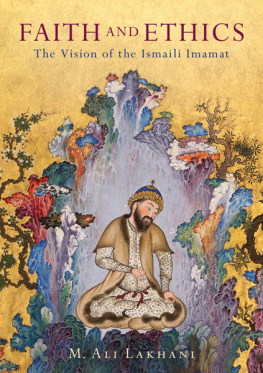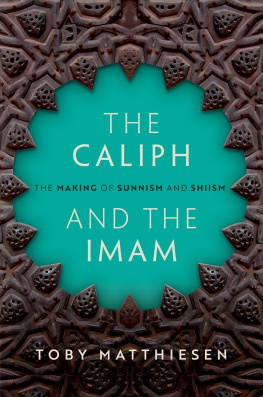

Published in 2018 by
I.B.Tauris & Co. Ltd
London New York
www.ibtauris.com
in association with The Institute of Ismaili Studies
210 Euston Road, London, NW1 2DA
www.iis.ac.uk
Copyright Islamic Publications Ltd, 2018
The moral rights of the author have been asserted.
All rights reserved. Except for brief quotations in a review, this book,
or any part thereof, may not be reproduced, stored in or introduced
into a retrieval system, or transmitted, in any form or by any means,
electronic, mechanical, photocopying, recording or otherwise, without
the prior written permission of the publisher.
Every attempt has been made to gain permission for the use of the
images in this book. Any omissions will be rectified in future editions.
References to websites were correct at the time of writing.
ISBN: 978 1 78831 248 6
eISBN: 978 1 78672 390 1
ePDF: 978 1 78673 390 0
A full CIP record for this book is available from the British Library
A full CIP record is available from the Library of Congress
Library of Congress Catalog Card Number: available

The Institute of Ismaili Studies
The Institute of Ismaili Studies was established in 1977 with the object of promoting scholarship and learning on Islam, in the historical as well as contemporary contexts, and a better understanding of its relationship with other societies and faiths.
The Institutes programmes encourage a perspective which is not confined to the theological and religious heritage of Islam, but seeks to explore the relationship of religious ideas to broader dimensions of society and culture. The programmes thus encourage an interdisciplinary approach to the materials of Islamic history and thought. Particular attention is also given to issues of modernity that arise as Muslims seek to relate their heritage to the contemporary situation.
Within the Islamic tradition, the Institutes programmes promote research on those areas which have, to date, received relatively little attention from scholars. These include the intellectual and literary expressions of Shiism in general, and Ismailism in particular.
In the context of Islamic societies, the Institutes programmes are informed by the full range and diversity of cultures in which Islam is practised today, from the Middle East, South and Central Asia and Africa to the industrialised societies of the West, thus taking into consideration the variety of contexts which shape the ideals, beliefs and practices of the faith.
These objectives are realised through concrete programmes and activities organised and implemented by various departments of the Institute. The Institute also collaborates periodically, on a programme-specific basis, with other institutions of learning in the United Kingdom and abroad.
The Institutes academic publications fall into a number of interrelated categories:
1. Occasional papers or essays addressing broad themes of the relationship between religion and society, with special reference to Islam.
2. Monographs exploring specific aspects of Islamic faith and culture, or the contributions of individual Muslim thinkers or writers.
3. Editions or translations of significant primary or secondary texts.
4. Translations of poetic or literary texts which illustrate the rich heritage of spiritual, devotional and symbolic expressions in Muslim history.
5. Works on Ismaili history and thought, and the relationship of the Ismailis to other traditions, communities and schools of thought in Islam.
6. Proceedings of conferences and seminars sponsored by the Institute.
7. Bibliographical works and catalogues which document manuscripts, printed texts and other source materials.
This book falls into category 1 listed above.
In facilitating these and other publications, the Institutes sole aim is to encourage original research and analysis of relevant issues. While every effort is made to ensure that the publications are of a high academic standard, there is naturally bound to be a diversity of views, ideas and interpretations. As such, the opinions expressed in these publications must be understood as belonging to their authors alone.
In loving memory of my parents,
Ibrahim and Kulsam,
who lived the ethics of their faith
Bani Adam
The sons of Adam are limbs of each other,
Having been created of one essence.
When the calamity of time affects one limb
The other limbs cannot remain at rest.
If you have no sympathy for the troubles of others,
You are unworthy to be called by the name of a Human.
Sadi of Shiraz
Bani Adam from Gulistan by the Persian poet, Sadi (d. 1292). The text of this verse is inscribed at the entrance of the United Nations building in New York.
Illustrations
Frontispiece
Chapter 1
Chapter 2
Chapter 3
Chapter 4
Chapter 5
Chapter 6
Chapter 7
Chapter 8
Chapter 9
Chapter 10
Note on Illustrations
Cover and Frontispiece
[Sultan Muhammad, The Court of Gayumars, c.1522, 47 32 cm, opaque watercolour, ink, gold, silver on paper, folio 20v, Shahnameh of Shah Tahmasp I (Safavid), Tabriz, Iran (Aga Khan Museum, Toronto)].
The cover depicts King Gayumars, the legendary first king of Persia. The painting of him is a detail from a scene depicting his Court, shown in the frontispiece. King Gayumars son, Siyamak, is standing to the right, while his grandson, Hushang, is seated to the left. The royal family is shown as elevated above the terrestrial realm of the lower court, where the subjects gather in an orderly circle. The whole scene symbolises cosmic order.
The King is the prototype of the imago Dei or al-insan al-kamil (Perfect Man). He represents the spiritually centred ruler who is the khalifa or vicegerent of God on earth. He is the measure of order, of justice, and he thereby depicts the humane potential of humanity what the poet Sadi refers to as being a Human (in the Bani Adam verse that is the epigraph to this book). The King is the microcosm.
The complete Court scene is the macrocosm. The arrangement descends from the celestial to the terrestrial, from the King to the Commons, reflecting the traditional devolution of order from the Sacerdotum (kingdom of spiritual governance, symbolising the Spirit and its faculty of higher intellect) to the Regnum (kingdom of human governance, symbolising the soul and its faculty of the psyche) and thence to the Commons (the subjects to be governed, symbolising the lower self and its appetites). Order, premised on verticality, and equilibrium, based on complementarity, are both represented in the painting, as is pluralism, which is evident in the diversity of the community of the Court.
The cover depicts the ethical and humane man. The frontispiece represents a vision of the ordered universe, acknowledging the norms of hierarchy and complementarity, which are a fundamental feature of Ismaili ethics.
Preface
At a time when Islam is under great scrutiny, when it is beset by fragmentary forces from within and without, when horrific acts are undertaken in its name acts which most Muslims consider appalling and defamatory of their faith and when its very nature is both misrepresented and misunderstood, there is a need to take a fresh look at its ethos. This book does just this, through the prism of the Ismaili branch of Islam, with particular focus on the outlook and example of Prince Karim al-Husseini, the fourth Aga Khan and of the Ismaili Imamat institutions he has established.












